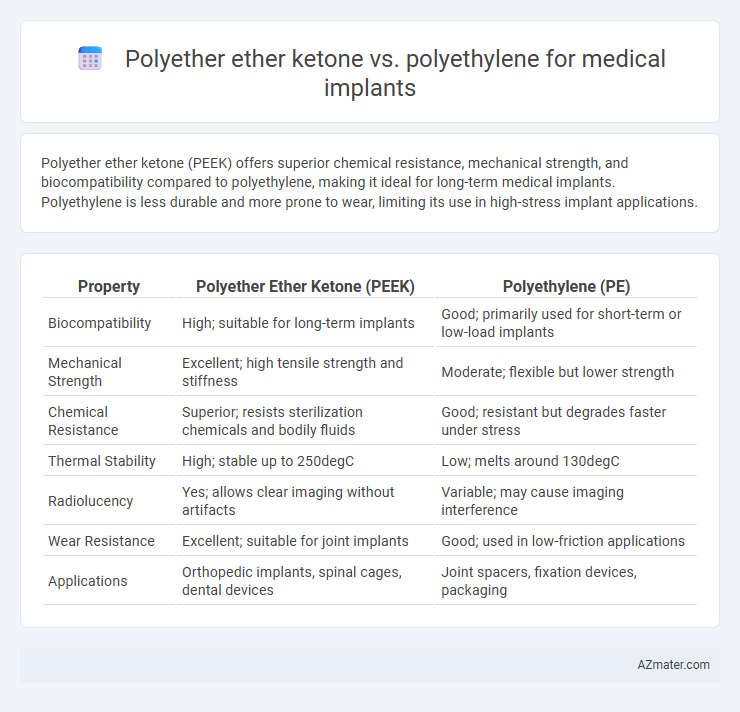Polyether ether ketone (PEEK) offers superior chemical resistance, mechanical strength, and biocompatibility compared to polyethylene, making it ideal for long-term medical implants. Polyethylene is less durable and more prone to wear, limiting its use in high-stress implant applications.
Table of Comparison
| Property | Polyether Ether Ketone (PEEK) | Polyethylene (PE) |
|---|---|---|
| Biocompatibility | High; suitable for long-term implants | Good; primarily used for short-term or low-load implants |
| Mechanical Strength | Excellent; high tensile strength and stiffness | Moderate; flexible but lower strength |
| Chemical Resistance | Superior; resists sterilization chemicals and bodily fluids | Good; resistant but degrades faster under stress |
| Thermal Stability | High; stable up to 250degC | Low; melts around 130degC |
| Radiolucency | Yes; allows clear imaging without artifacts | Variable; may cause imaging interference |
| Wear Resistance | Excellent; suitable for joint implants | Good; used in low-friction applications |
| Applications | Orthopedic implants, spinal cages, dental devices | Joint spacers, fixation devices, packaging |
Introduction to Polyether Ether Ketone (PEEK) and Polyethylene
Polyether ether ketone (PEEK) is a high-performance thermoplastic known for its exceptional mechanical strength, chemical resistance, and biocompatibility, making it ideal for medical implants such as spinal cages and orthopedic devices. Polyethylene, particularly ultra-high-molecular-weight polyethylene (UHMWPE), is widely used in joint replacements due to its excellent wear resistance and low friction properties. The choice between PEEK and polyethylene depends on factors like load-bearing capacity, wear characteristics, and compatibility with human tissue.
Material Properties Comparison
Polyether ether ketone (PEEK) offers superior mechanical strength, chemical resistance, and biocompatibility compared to polyethylene (PE) in medical implants, supporting long-term durability and stability under physiological conditions. PEEK exhibits higher tensile strength (approximately 90-100 MPa) and a melting point around 343degC, whereas polyethylene has lower tensile strength (20-40 MPa) and a melting point near 130degC, limiting its use in high-stress applications. The excellent fatigue resistance and radiolucency of PEEK make it preferable for orthopedic and spinal implants, while polyethylene is commonly used in low-load bearing applications such as joint liners.
Mechanical Strength and Durability
Polyether ether ketone (PEEK) exhibits superior mechanical strength and durability compared to polyethylene, making it ideal for high-stress medical implants such as spinal cages and joint replacements. PEEK maintains excellent dimensional stability and resists wear, chemical degradation, and fatigue under physiological conditions, extending implant longevity. In contrast, polyethylene, while biocompatible and flexible, demonstrates lower tensile strength and is more prone to wear and deformation, limiting its use to less mechanically demanding applications like some articulating surfaces in joint prostheses.
Biocompatibility and Bioinertness
Polyether ether ketone (PEEK) outperforms polyethylene in medical implants due to its superior biocompatibility and bioinertness, minimizing inflammatory responses and promoting tissue integration. PEEK's chemical stability and resistance to degradation under physiological conditions ensure long-term implant durability without eliciting adverse immune reactions. In contrast, polyethylene may induce wear particles that trigger localized inflammation and potential implant loosening, limiting its application in critical load-bearing implants.
Chemical Resistance in Biological Environments
Polyether ether ketone (PEEK) exhibits superior chemical resistance in biological environments compared to polyethylene, maintaining structural integrity and performance when exposed to bodily fluids, enzymes, and sterilization processes. PEEK's aromatic backbone and ketone groups provide enhanced resistance to hydrolysis and oxidation, critical for long-term medical implants. In contrast, polyethylene may degrade more rapidly due to susceptibility to oxidation and absorption of lipids, limiting its durability in implant applications.
Applications in Medical Implants
Polyether ether ketone (PEEK) is widely utilized in medical implants due to its exceptional biocompatibility, mechanical strength, and resistance to sterilization processes, making it ideal for spinal cages, orthopedic devices, and dental implants. Polyethylene, particularly ultra-high-molecular-weight polyethylene (UHMWPE), is primarily used in joint replacement implants such as hip and knee prostheses for its low friction, high wear resistance, and excellent toughness. The distinct properties of PEEK and polyethylene define their application scope, with PEEK offering superior structural support and polyethylene providing durable bearing surfaces within the human body.
Wear Resistance and Longevity
Polyether ether ketone (PEEK) exhibits superior wear resistance compared to polyethylene due to its higher mechanical strength and chemical stability, making it ideal for long-term medical implants. PEEK's enhanced durability significantly reduces particle generation from friction, minimizing inflammation and implant failure risks. The material's longevity in medical applications outperforms polyethylene, resulting in extended implant lifespan and improved patient outcomes.
Radiolucency and Imaging Compatibility
Polyether ether ketone (PEEK) offers superior radiolucency compared to polyethylene, allowing for clearer and more accurate imaging during medical implant evaluations. Its chemical structure results in minimal interference with X-rays, CT scans, and MRI, enhancing diagnostic precision without image artifacts. Polyethylene, while biocompatible, tends to be less radiolucent, which can obscure detailed imaging and complicate postoperative assessments.
Cost Considerations and Availability
Polyether ether ketone (PEEK) offers high-performance mechanical properties and biocompatibility for medical implants but comes at a significantly higher cost compared to polyethylene, which is widely available and economical. Polyethylene, especially ultra-high-molecular-weight polyethylene (UHMWPE), is commonly used in joint replacements due to its lower price and widespread availability through multiple manufacturers. Cost considerations favor polyethylene for budget-sensitive applications, while PEEK's superior durability and resistance justify its expense in specialized, long-term implant uses.
Future Trends in Medical Implant Materials
Polyether ether ketone (PEEK) is emerging as a superior choice over polyethylene in medical implants due to its exceptional biocompatibility, mechanical strength, and chemical resistance, enabling longer-lasting and more reliable implant performance. Advances in polymer science are driving the development of PEEK composites enhanced with bioactive materials, promoting tissue integration and reducing inflammation risk. Future trends indicate a shift towards multifunctional implants using PEEK-based materials that combine structural support with smart drug delivery and real-time monitoring capabilities.

Infographic: Polyether ether ketone vs Polyethylene for Medical implant
 azmater.com
azmater.com